Journal
"Zion" and "Jerusalem" as Lady Wisdom in Moses 7 and Nephi's Tree of Life Vision

Title
"Zion" and "Jerusalem" as Lady Wisdom in Moses 7 and Nephi's Tree of Life Vision
Publication Type
Journal Article
Year of Publication
2014
Authors
Zinner, Samuel (Primary)
Journal
Interpreter: A Journal of Latter-day Saint Faith and Scholarship
Pagination
281-323
Volume
12
Abstract
The essay traces lines of continuity between ancient middle eastern traditions of Asherah in her various later Jewish, Christian, and Mormon forms. Especially relevant in Jewish texts are Lady Wisdom (Proverbs 8; Sirach 24; Baruch 3-4), Daughter of Zion (Lamentations; Isaiah); Lady Zion and Mother Jerusalem (4 Ezra), Binah in kabbalah etc. The divine feminine in the Jewish-Christian texts Odes of Solomon 19 and Shepherd of Hermas is examined, as well as in Pauline Christian texts, namely, the Letter to the Galatians and the writings of Irenaeus (Against Heresies and Apostolic Preaching). Dependence of Hermas on the Parables of Enoch is documented. The essay identifies parallels between some of the above ancient sources and traditions about Zion and other forms of the feminine divine in 19th century America, specifically in the Mormon scriptures (Moses 7 and Nephi 11). While recognizing the corporate nature of the Enochic city of Zion in Moses 7, the essay argues that this Zion also parallels the hypostatic Lady Zion of Jewish canonical and extracanonical scriptures, especially 4 Ezra. The essay also points how the indigenous trope of Mother Earth parallels forms of the divine feminine stretching from the ancient middle eastern Asherah, the Jewish Lady Wisdom and Shekhinah, the Christian Holy Spirit, to the Mormon Enochic Zion.
Subject Keywords
Bibliographic Citation
Terms of use
Items in the BMC Archive are made publicly available for non-commercial, private use. Inclusion within the BMC Archive does not imply endorsement. Items do not represent the official views of The Church of Jesus Christ of Latter-day Saints or of Book of Mormon Central.